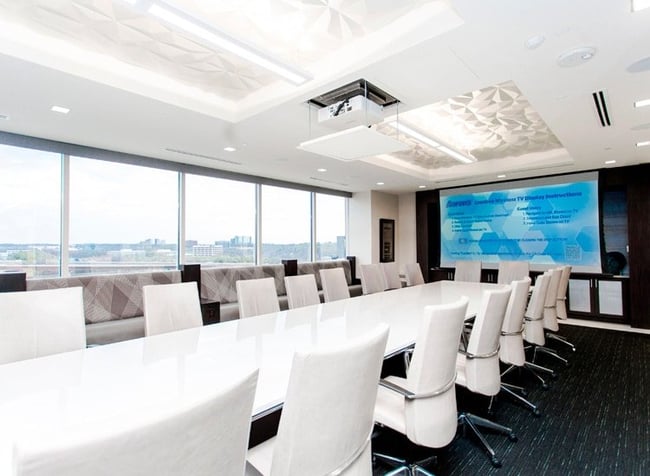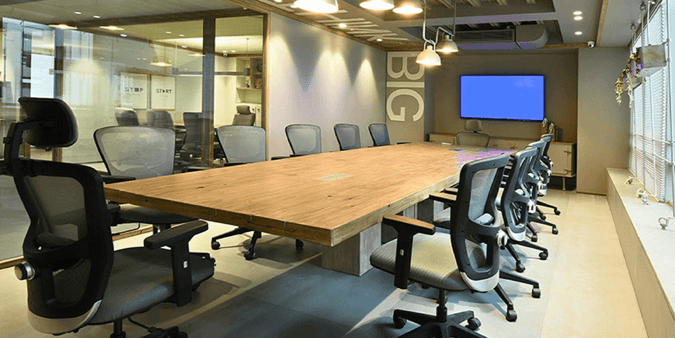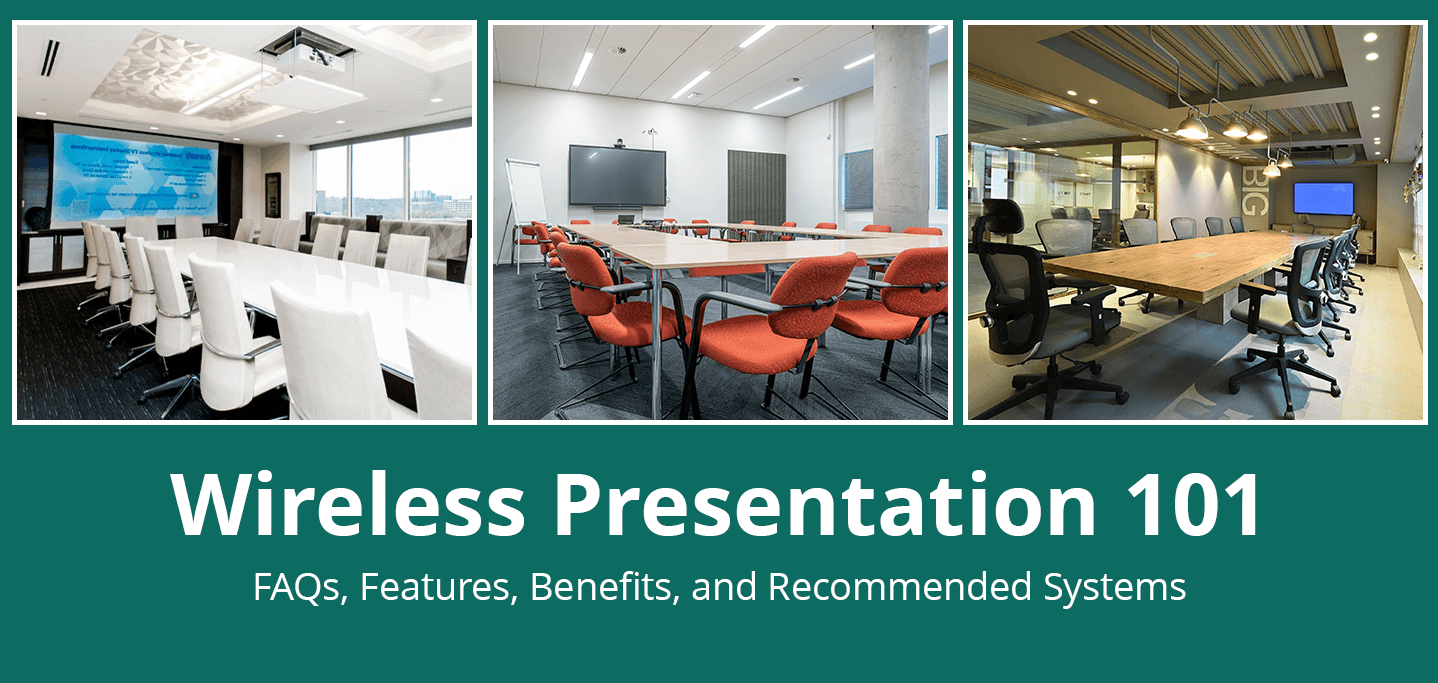Wireless presentation systems are growing in popularity, and rightfully so. They allow users to seamlessly collaborate and share ideas, documents, and desktops on projectors, TVs, and big screens. This functionality is ideal for boardrooms, conference rooms, lecture halls, classrooms, and more.
There are many wireless presentation systems in the marketplace, each of them has its advantages and disadvantages. The right solution depends on a variety of factors like budget, necessary features, required connections, type of users, etc.
This article will review the benefits, features, questions to ask before starting, and recommended systems.
Let’s dive in.
What is a Wireless Presentation System?
A wireless presentation system allows users to project content, on any device, to a display using a wireless network. This technology makes it easy for presenters to share ideas, concepts, documents, and media to projectors, TVs, and large monitors– without having to use restrictive hardwired connections.

When should you use one?
If you want to project from one device to another, wireless presentation systems are a user-friendly solution. Some specific use cases that come to mind are:
- If you want to wirelessly connect your smartphone or tablet to a TV in the breakroom
- If you’re going to project your video conference onto a projector in the boardroom
- If vendors or clients with different devices need to connect and present to the displays in a conference room
- If team members want to brainstorm and share screens simultaneously in a huddle room
Benefits of Wireless Presentation Systems
Removing the wireless and cables makes it easier to collaborate and interact seamlessly. In fact, Gartner Research determined that wireless presentation systems are one of the top 10 strategic technologies to improve BYOD collaboration. Here are some of the reasons why.
Reduce Touchpoints
Minimizing common touchpoints is crucial to reducing the spread of germs. Cordless solutions minimize high-touch and hard to sanitize surfaces like USBs, HDMI cables, and volume buttons. In the post-pandemic world, it's essential to provide clean and safe collaboration solutions.
Support BYOD
It doesn’t matter if you use a MacBook, PC, Chromebook, iPad, tablet, iPhone, or Android. Anyone can connect with a wireless presentation system. Users need to visit a website or download a simple software file to present in seconds. Removing cords and adaptors allows everyone to put their best device forward.

Enhance Room Design
Architects and designers go to great lengths to create beautiful conference rooms. Then you slap an AV system in there, and it throws off the Fengshui. With traditional presentation systems, you have a bulky device on the table with cords strewn around the room. To hide the clutter, you have to drill holes in tables, design cable trays, and hunt for cables and connectors when it’s time to present. Most wireless systems are compact devices discretely mounted behind the displays. Minimizing the clutter makes it easier to focus on the presenter rather than the mess of cables.
Easier Presenting
How many meetings have started late because you had to call the IT team to get the projector to work? From the user’s laptop to the cables, connectors, and AV systems – there’s a whole lot of debugging to do when something goes wrong. Not only that but with a hardwired connection, the presenter is limited by the cable length. Wireless systems allow users to connect from several yards away, so they can walk around the room freely. Workplace technology should be professional, user-friendly, and make your team’s lives easier. Wireless presentation systems help make that possible.
Cost-Effective
Since wireless systems inherently remove cables and adaptors, you save money on hardware. Extra savings come from not having to hide all those cables and wires in the first place. Think: cable boxes, raceways, and custom tables. And while you may have to pay for additional configuration and installation upfront, your IT team can stop wasting time troubleshooting conference room technology and focus on more value-adding initiatives.
Wireless Presentation System Features
Wireless presentation systems come with all the features that wired connections do, and then some. But, of course, you get what you pay for. Additional functionality comes with a bigger price tag, but the upfront investment can quickly generate an ROI when your team effectively collaborates and communicates digitally.
High-Resolution
Between looking at spreadsheets and video conferencing, you need to read text and see faces clearly on your displays. Commercial-grade systems can deliver resolutions from 1080p to 4K. Presentation systems can handle video differently depending on the model and configuration, but many systems can play videos at frame rates up to 60 frames per second.
Clear Audio
Sometimes a crisp display is all you need, but most times, you need clear audio to go with it. After all, what’s the point of a presentation if the people online can’t hear you? Wireless systems can deliver natural-sounding audio at a comfortable level. It will sound like virtual participants are in the room with you.
Security
Your presentation systems can be as secure as your IT team deems necessary. You can have an open connection that anyone can access. A screen key, so a user has to be in the room with the code to connect. Or you can make it password-protected or AES-128 encrypted. Your IT team calls the shots.

Multiple Screens
Systems can display a single screen, split-screen, and some support quad-screens. This functionality is ideal if you want to video conference and need to look at participants, the host, information (spreadsheets, images, slides), and anything else being shared.
7 Questions to Ask Before Getting a Wireless Presentation System
Before shopping around or contacting a vendor, knowing what you want and need in a system is essential. This will make it easier to find a solution that checks all the boxes. So take the time to review these questions and let your answers guide your system selection.
1. Who will be using the system?
Will only employees connect and present, or will you have guests too? More users and a greater variety of devices make for a more complex solution. Most likely, your office has a BYOD (Bring Your Own Device) culture, in which case you’ll need to provide more options for people to connect. It’s best to give them wired and wireless options as well as apps and download options. You need to be prepared for various operating systems so that everyone can walk in and seamlessly connect.
Case Study: Coworking space complex AV design, install, and support.
2. How will you get software onto the presentation device?
Options include apps, programs, and downloads. For employee computers, a global installation can be the easiest and quickest route. This allows everyone to connect the same way. However, things get sticky when guests present or employees bring their own devices like tablets and phones.
3. Do you want software-only or an external device?
Some systems have external devices and dongles that allow you to click a button and show your screen. These devices simplify the connection process and can be easy to use. But, they can also disappear, and some computer security settings won’t run files from external devices. Downloading software is a great alternative, but it can take guests a while to download and install before presenting.
4. Do you have single or dual networks?
One of the biggest issues we see is that devices work well on the owner’s network but run into problems with guests. Typically, guests are not connected to the same network as employees. Most presentations need you to be connected to the same network to present. Some newer devices have two network cards allowing them to connect to two networks. Ex: Guest WiFi vs. Internal WiFi. This enhanced functionality is a game-changer if you know that you’ll have guests and employees using the system.

5. Do you need single or dual displays?
As we mentioned, some wireless presentation systems can show on 2+ displays. These options are incredible for improving collaboration capabilities and efficiency. They allow multiple users to work together and run multiple displays simultaneously. This enhanced functionality is great, but you will need to budget accordingly.
6. What are your maintenance and administration requirements?
For this, you need to consider the size of your organization. Do you have one conference room in your office or dozens? Some devices require you to make changes at the device level. This means you have to log in and update things like firmware or the splash screens individually. Other devices have software portals that allow you to administer all the devices on the network globally. The latter is a huge advantage (and a time saver!) if you have many devices or a lot of locations.
7. What is your budget?
This is one of the first questions we get asked, and unlike most vendors, we do our best to be transparent with our pricing. You can budget anywhere from $800-$4,000. Most wireless presentation solutions cost around $1,000-2,000, with some sticking out in the higher/lower end of the price range. It ultimately boils down to what kind of functionality you need.
Click here to learn more about factors that influence AV project costs.
Recommended Systems
We deal with a wide variety of manufacturers and devices. We can only make the best recommendation if we know more about your individual needs. (Hint: start by answering the questions in the section above!)
The most popular brands range between $1,000 and $2,000 but will need to be installed and configured. Some of the most common brands we see are listed below.

Crestron AirMedia
Add to an existing room setup or integrate with other Crestron systems for a true smart room experience. Occupancy sensors to turn the room on/off, touchscreens for easy collaboration, and mobile room controls. Crestron AirMedia is made for the commercial environment. It’s easy to provision, manage, and deploy across your organization.

Barco CickShare
Plug the USB button into a laptop and click to connect to your speakers, screens, and microphones. The dongle can be quickly disinfected and is low profile enough to leave on the table or put into a drawer when not in use. There’s also a mobile app so that users can share their mobile or tablet screen. The ISO-certified platform adheres to the highest security standards.

Mersive Solstice
The Mersive Solstice is a high-performance, in-room meeting collaboration platform that drives more engaging and productive meetings. Users can connect and share content from any device in one simple step; no cables or dongles are required. In addition, it can be easily managed, monitored, and analyzed from the cloud platform.
Conclusion
Like all workplace technology, it’s important to do your research before purchasing. Knowing what to look for and the most relevant nuances to your organization and use cases will help you get the right system.
Speaking with an experienced AV professional can help you get the best price on a system and ensure a smooth installation. This way, you have the right system... and a system that works where and when you need it.
Want to learn more about pricing? Check out our Audio Visual Purchasing Guide, where we cover all the factors that influence cost.



Leave a Comment